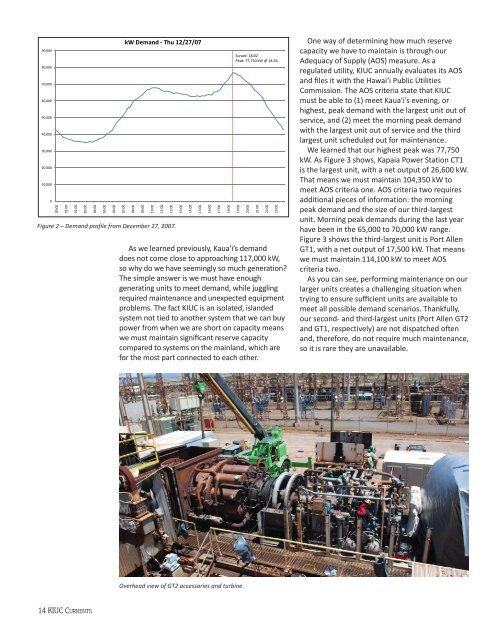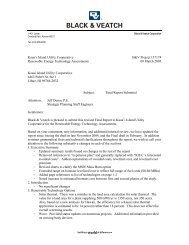Safer is Smarter - Kauai Island Utility Cooperative
Safer is Smarter - Kauai Island Utility Cooperative
Safer is Smarter - Kauai Island Utility Cooperative
You also want an ePaper? Increase the reach of your titles
YUMPU automatically turns print PDFs into web optimized ePapers that Google loves.
14 KIUC CURRENTS<br />
<br />
<br />
<br />
Figure 2 – Demand profile from December 27, 2007.<br />
<br />
<br />
<br />
<br />
<br />
<br />
<br />
<br />
<br />
<br />
<br />
<br />
As we learned previously, Kaua‘i’s demand<br />
does not come close to approaching 117,000 kW,<br />
so why do we have seemingly so much generation?<br />
The simple answer <strong>is</strong> we must have enough<br />
generating units to meet demand, while juggling<br />
required maintenance and unexpected equipment<br />
problems. The fact KIUC <strong>is</strong> an <strong>is</strong>olated, <strong>is</strong>landed<br />
system not tied to another system that we can buy<br />
power from when we are short on capacity means<br />
we must maintain significant reserve capacity<br />
compared to systems on the mainland, which are<br />
for the most part connected to each other.<br />
Overhead view of GT2 accessories and turbine.<br />
<br />
<br />
<br />
<br />
<br />
<br />
<br />
<br />
One way of determining how much reserve<br />
capacity we have to maintain <strong>is</strong> through our<br />
Adequacy of Supply (AOS) measure. As a<br />
regulated utility, KIUC annually evaluates its AOS<br />
and files it with the Hawai‘i Public Utilities<br />
Comm<strong>is</strong>sion. The AOS criteria state that KIUC<br />
must be able to (1) meet Kaua‘i’s evening, or<br />
highest, peak demand with the largest unit out of<br />
service, and (2) meet the morning peak demand<br />
with the largest unit out of service and the third<br />
largest unit scheduled out for maintenance.<br />
We learned that our highest peak was 77,750<br />
kW. As Figure 3 shows, Kapaia Power Station CT1<br />
<strong>is</strong> the largest unit, with a net output of 26,600 kW.<br />
That means we must maintain 104,350 kW to<br />
meet AOS criteria one. AOS criteria two requires<br />
additional pieces of information: the morning<br />
peak demand and the size of our thirdlargest<br />
unit. Morning peak demands during the last year<br />
have been in the 65,000 to 70,000 kW range.<br />
Figure 3 shows the thirdlargest unit <strong>is</strong> Port Allen<br />
GT1, with a net output of 17,500 kW. That means<br />
we must maintain 114,100 kW to meet AOS<br />
criteria two.<br />
As you can see, performing maintenance on our<br />
larger units creates a challenging situation when<br />
trying to ensure sufficient units are available to<br />
meet all possible demand scenarios. Thankfully,<br />
our second and thirdlargest units (Port Allen GT2<br />
and GT1, respectively) are not d<strong>is</strong>patched often<br />
and, therefore, do not require much maintenance,<br />
so it <strong>is</strong> rare they are unavailable.
















